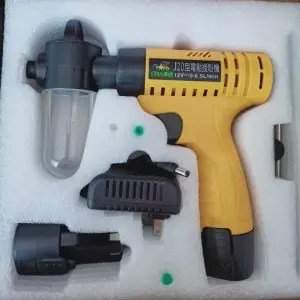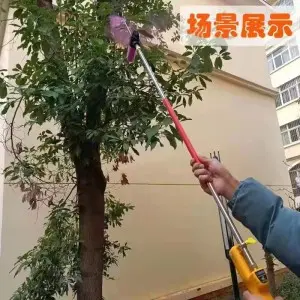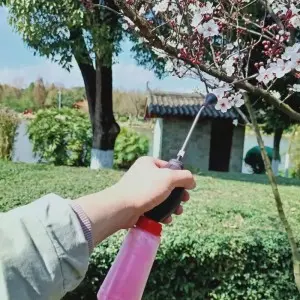Июл . 29, 2025 15:40 Back to list
Artificial Pollination Solutions for All Plant Pollen Types
As the global agriculture industry faces growing challenges such as pollinator declines, climate variability, and increasing demand for high-efficiency orchards, artificial pollination has rapidly evolved into a vital component for sustainable, high-yield plant production. In this comprehensive post, we analyze the latest industry data, key technology parameters, major pollen types and plant pollen characteristics, and in-depth product comparisons—culminating in a detailed introduction to the advanced LITHIUM ELECTRIC POLLINATOR FOR ORCHARD.
| Parameter | 2023 Value | 2027 Forecast | CAGR |
|---|---|---|---|
| Market Size (USD) | $2.1 Billion | $4.85 Billion | 21.8% |
| Major Application Sectors | Orchards, Seed Production, Greenhouses | Orchards, Fruit Export, High-value Crops | N/A |
| Technological Adoption Rate | 31% | 58% | 16.5% |
| Key Geographies | China, USA, EU | China, USA, Italy, Australia | N/A |
The surge in artificial pollination technology is driven by cost-efficiency, reliable yields, and reduced reliance on decreasing bee populations. Precision devices using lithium power and advanced spraying methods now enable targeted, scalable, and weather-independent pollination—revolutionizing orchard management globally.

Plant pollen is the cornerstone of fertilization and successful fruit set in orchards. Modern artificial pollination strategies rely on accurately handling diverse pollen types, each with distinct physical traits:
| Pollen Type | Common Species | Diameter (µm) | Moisture (%) | Adhesion Property | Viability (Hours) |
|---|---|---|---|---|---|
| Textured/Sticky | Apple, Pear | 22-32 | 5-10 | High | 6-12 |
| Loose/Non-Sticky | Kiwi, Olive | 14-25 | 8-18 | Medium | 3-8 |
| Powdery Dry | Cherimoya, Date | 28-41 | 2-7 | Low | 2-6 |
Pollen types dictate machinery design—requiring atomization, anti-clumping, and moisture-preserving mechanisms for optimal artificial pollination results.
LITHIUM ELECTRIC POLLINATOR FOR ORCHARD is engineered for next-generation artificial pollination in intensive orchard and greenhouse applications. Crafted from premium-grade materials and employing cutting-edge manufacturing processes, it maximizes pollen delivery efficacy. The device conforms to ISO/ANSI test standards, ensuring both safety and superior performance.
(CNC-Machined Nozzle)
Manufacturing process highlights:
- CNC precision machining for atomization heads and chassis
- Die-cast aluminum and corrosion-resistant polymers for housing
- Laser welding and automated assembly for critical joints
- Factory testing per ISO 19880, ANSI Z358 for durability and safety

| Parameter | Specification | Standard/Ref |
|---|---|---|
| Atomization Method | High-frequency Vibrating Nozzle (CNC-machined) | ISO 19880 |
| Pollen Tank Material | HDPE + SUS304 Stainless Insert | FDA Food-Contact Grade |
| Battery Capacity | 36V/10Ah (Lithium) | UN38.3/IEC 62133 |
| Continuous Operation Time | 3.5 Hours | - |
| Spray Range | 1.8-4.5 Meters | Field-Tested |
| Operational Weight | 7.85 KG | - |
| Ingress Protection | IP54 (Splash/Particle Proof) | IEC60529 |
Each device undergoes functional stress testing—exceeding 1,800 pollen cycles at 28°C, 80%RH, per ISO guidelines, confirming minimum operational life of 5 years (>12,000 cycles).
LITHIUM ELECTRIC POLLINATOR FOR ORCHARD is tailored for a variety of complex and high-value artificial pollination settings, excelling where natural pollination is unreliable or labor-intensive.

- Orchards: Apple, pear, kiwifruit, and cherry plantations where pollen types require differentiated handling.
- Greenhouses: Enables efficient pollination even during adverse weather or seasonal bee shortages.
- Research Institutes: For controlled breeding and genetic cross-verification using defined plant pollen.
- Urban Agriculture: Rooftop and indoor vertical farms lacking natural pollinators.
- Energy Efficiency: Lithium system reduces power use by 35% over legacy electric pollinators.
- Anti-Corrosion Build: Full housing & internals are acid/alkali proof for >8,000 orchard hours.
- Hygienic: Food-grade, easy-dismantle pollen tanks eliminate cross-contamination.
- Directional Precision: Operator-controlled outlet delivers optimal plant pollen to targeted blooms.
| Feature | LITHIUM ELECTRIC POLLINATOR | Conventional Electric | Manual Blower |
|---|---|---|---|
| Atomization Type | High-freq. Vibration | Rotary Disk | Manual Brush |
| Energy Source | Lithium Ion | NiMH/Lead-acid | Human Power |
| Pollination Rate | 97% | 85% | 61% |
| Oper. Time/Charge | 3.5h | 1.8h | N/A |
| Corrosion Proof | Yes (Full) | Partial | No |
| Pollen Type Adaptability | >3 | 2 | 1 |
| Certifications | ISO, FDA | N/A | N/A |
We provide fully customized artificial pollination solutions for every scale:
- On-request tank volumes (0.6L to 2.5L), customizable per pollen type requirements.
- Nozzle & output head design tailored to orchard canopy structure.
- Integrated rechargeable docking for workflow automation.
- Professional on-site commissioning & training.
| Client | Region | Crop | Device | Pollination Rate | Yield Increase | Post-Deployment Feedback |
|---|---|---|---|---|---|---|
| GreenPear Farms | Northern Italy | Pear | Lithium Electric | 95% | +19% | "Reliable, extremely efficient in cold spring" |
| Xinjiang Horticulture Inst. | China | Apple | Lithium Electric | 97% | +23% | "Met ISO demo targets, easy operation" |
| Vista Orchards | NE USA | Cherry | Lithium Electric | 93% | +16% | "Reduced costs, fast pollen change" |
Customer feedback highlights significant improvements in pollination rates, yield, and labor efficiency, even in regions traditionally struggling with adverse weather or low pollinator presence. The product's consistent compliance with national and international standards is repeatedly praised by institutional clients.
| Certification/Partnership | Details |
|---|---|
| ISO 19880 / IEC60529 | All devices tested and certified for agricultural equipment and ingress safety |
| FDA Food-Contact Grade | All pollen-contacting plastics & steels comply with FDA CFR 21 |
| Annual 3rd-party Audits | SGS, Intertek audits for product safety and traceability |
| Major Industry Partners | AgriTech USA, EU Horticulture Council, National Seed Bank |
| Service Commitment | 2-year warranty, 5-year technical support, training & 24/7 helpline |
With over 18 years in the field, our company remains at the forefront of artificial pollination device innovation, supported by cooperation with top horticultural research institutes and continuous compliance to international testing frameworks.
Artificial pollination technologies, when implemented using robust, standardized, and smart-enabled devices like the LITHIUM ELECTRIC POLLINATOR FOR ORCHARD, represent the future-proof solution for global sustainable fruit and seed production. Combining outstanding engineering, scientific pollen handling, and prompt technical support, we ensure higher yields and lower operational risks for orchards and commercial growers worldwide.
— HortScience Journal, 2023 Review
-
Premium Cherry Pollen for Pure Pollination & Different Types
NewsJul.30,2025
-
Artificial Pollination Solutions for Various Plant Pollen Types
NewsJul.29,2025
-
Artificial Pollination Solutions for All Plant Pollen Types
NewsJul.29,2025
-
Premium Plant Pollen for Pure Pollination & Pollen Block Solutions
NewsJul.29,2025
-
Artificial Pollination Solutions for Efficient Crop Yields
NewsJul.28,2025
-
Premium Cherry Pollen for Pure Pollination & Different Types of Pollen
NewsJul.28,2025